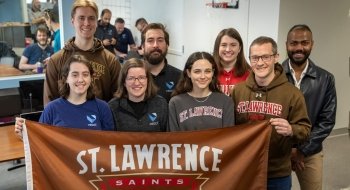Student Research Informs Energy Master Plan
Students research and inform how St. Lawrence University can function in a more sustainable manner

Four students took the lead in conducting important research to help inform St. Lawrence’s first-ever energy master plan, a road map for determining how the University will invest in energy-related projects and purchases.
Lucy Hochschartner ’20 of Lake Placid, New York, who is majoring in environmental studies, investigated how St. Lawrence could incorporate its current and future clean energy projects into the greater North Country community. Erin Waters ’19 of Concord, New Hampshire, who is majoring in environmental studies and minoring in art and art history, focused on how to enhance the University’s dining venues, especially Dana Dining Hall, to provide quality and efficiently prepared food. Georgia Grzywacz ’20 of Cross River, New York, who is majoring in environmental studies-sociology, researched the use of renewable fuel oil as an alternative energy source and the environmental and economic benefits associated with its implementation. Hogan Dwyer ’19 of South Orange, New Jersey, who is majoring in environmental studies and minoring in outdoor studies, evaluated energy efficiency technologies for heating and cooling at the University.
According to Ryan M. Kmetz, assistant director of sustainability and energy management, these projects were tailored from aspects of energy and sustainability topics that the students were most passionate about and designed in a way to fit the energy master plan.
“Geothermal energy is becoming much more cost-effective in relation to windows” says Dwyer, who found that implementing efficient technologies may be more cost-effective when building than when retrofitting due to the long timeline in recovering investments when retrofitting. He believes that introducing these technologies in the building process has massive potential for savings at St. Lawrence through simple investments such as state-of-the-art plumbing equipment and lighting.
Kmetz says that each project carried out by the four interns complemented the University’s plan. The student researchers also had the opportunity to work with other stakeholders in the process such as the University’s engineering consulting firm, Wendel, the Campus Committee on Sustainability and Climate Neutrality (CCSCN), as well as Dining Services and the Business Office.
“St. Lawrence is at the forefront with this energy master plan,” Kmetz says. “Other universities have either just started investigating their energy consumption or just completing their investigations.”
Planning for the energy master plan began in summer 2017, after the University secured $112,500 through New York State Energy Research and Development Authority’s REV Campus Challenge. The plan, designed to give guidance on future energy investments and decisions and advise on building-level energy reductions, also provided $4,000 in funding for student internships. The four St. Lawrence students worked under the guidance of Kmetz and participated in individual sustainability research projects that ultimately informed the University’s planning process.
The summer 2018 addition of the University’s purchase of over 3 million kilowatt hours annually of solar power from the Watertown solar facility in Jefferson County, New York, is one example of decisions based on St. Lawrence’s completed energy master plan. Future decisions will also be based on the broad institutional goals to efficiently meet utility services requirements, address sustainability strategies, and provide a dynamic foundation for continuous reassessment and review of utility infrastructure life-cycle strategies. Kmetz believes that student research will continue to inform the future energy plans of the institution.
To learn more about the energy master plan visit: stlawu.edu/green/energy-master-plan.




